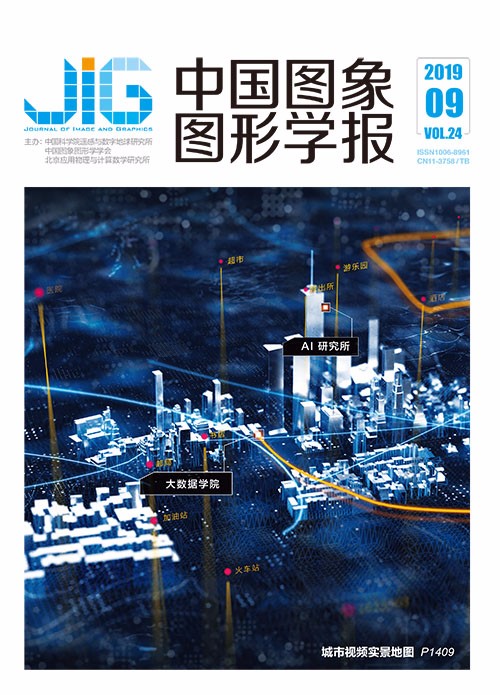
结合网格密度聚类的行人检测候选域生成
摘 要
目的 行人检测是计算机视觉领域中的重点研究问题。经典的可变形部件模型(DPM)算法在行人检测领域素有高检测精度的优点,但由于在构建特征金字塔前处理过多召回率低的候选区域,导致计算速度偏慢,严重影响系统的实时性。针对该问题,本文对模型中选取候选检测区域的流程进行了改进,提出一种结合网格密度聚类算法和选择性搜索算法的行人检测候选对象生成方法来改进DPM模型。方法 首先使用三帧差法和高斯混合模型收集固定数量的运动物体坐标点,然后结合基于网格密度的聚类算法构建网格坐标模型,生成目标频繁运动区域,同时进行动态掩层处理。随后引入改进的选择性搜索算法,结合支持向量机(SVM)训练得到的行人轮廓宽高比,提取该区域中高置信度的行人候选检测窗口,从而排除大量冗余的区域假设,完成对候选行人检测区域的精筛选,最后融合至DPM算法进行行人检测。结果 所提方法在PETS 2009 Bench-mark数据集上进行检测,实验结果表明,该方法对复杂背景下的检测有较强的稳定性,与传统DPM模型相比,精度提高了1.71%、平均对数漏检率降低2.2%、检测速度提高为3.7倍左右。结论 本文提出一种基于网格密度聚类的行人检测候选域生成算法,能够有效表达行人信息,与其他行人检测算法相比,有更好的精度和更快的速度,在检测率、检测时间方面均有提高,能够实现有效、快速的行人检测,具有实际意义。
关键词
Candidate domain generation for pedestrian detection combined with grid density clustering
Cheng Keyang1,2, Zhou Bowen1, Li Shichao1, Sun Shuang1(1.School of Computer Science and Communication Engineering, Jiangsu University, Zhenjiang 212000, China;2.National Engineering Laboratory for Public Safety Risk Perception and Control by Big Data, Beijing 100846, China) Abstract
Objective Pedestrian detection is an important research topic in computer vision and plays a crucial role in all parts of life. The deformable part model (DPM) algorithm is a graphical model (Markov random field) that uses a series of parts and the spatial positional relationship of parts to represent an object. The DPM algorithm achieves superior detection accuracy in the field of pedestrian detection. However, because the DPM algorithm uses a sliding window strategy to search for objects in images, it handles a large number of candidate areas with low recall rates before constructing the feature pyramid. This property restricts the detection efficiency of the DPM algorithm. In view of this problem, this study proposes a novel model to improve the process of selecting candidate detection regions and puts forward the DPM algorithm integrated with a clustering algorithm with grid density and a selective search algorithm. Compared with the sliding window search method, the proposed model can provide fewer proposal windows and thus reduces computational complexity. Therefore, this study focuses on the advantages of the proposed model and the DPM algorithm to improve detection efficiency and accuracy. Method The proposed model contains three modules:the collection module of the coordinate points of moving targets, the generation module of frequently moving regions of targets, and the generation module of candidate detection windows. The modules are executed in series. Three frame difference methods and Gauss mixture models are used to detect moving targets in the first module. The centroid coordinates of each effective target are calculated by the obtained object contour, and a certain number of moving object coordinate points are collected and stored in the queue. In the second module, a G-cluster clustering algorithm based on grid structure and DBSCAN (density-based spatial clustering of applications with noise) clustering is proposed. The greatest advantage of the DBSCAN clustering algorithm is that it can find clusters of different sizes and shapes. However, this algorithm requires traversing every data point in the dataset, thereby leading to a high running time cost. Therefore, we draw lessons from the idea of the grid clustering algorithm based on the DBSCAN clustering algorithm. We develop a grid coordinate model and use the sliding window search method with an adaptive step size instead of neighborhood search to improve the method. This method can greatly reduce the number of data point searches and accelerate the speed of clustering. The specific experimental steps are as follows. The data points in the queue (QUE) are read, and the grid coordinate model is constructed. Frequently moving regions of targets are found by the sliding window strategy with an adaptive step size. Each region is dynamically adjusted with the aid of the moving object detection algorithm, and then the non-frequently moving regions are processed by masking to improve the effects of the candidate window generation module following the generation of frequently moving regions. Finally, the processed images are entered into the next module. In the third module, an improved selective search algorithm is introduced. As a mature image segmentation algorithm, the selective search algorithm can detect object proposals rapidly and effectively. It can also satisfy the accuracy and real-time requirements of pedestrian detection. Therefore, this thesis uses the selective search algorithm to extract a target from an image, and obtains a series of windows with high probability of complete target extraction. To further exclude the candidate windows with low credibility, we count and adjust the width-height ratio of the pedestrian contours in the INRIA dataset of public pedestrian image datasets. The range of the target width-height ratio is considered the condition for further screening candidate windows. Then, according to the coordinates of the final candidate detection window on the image, the corresponding features are extracted and entered into the classifier of the DPM algorithm. The final pedestrian detection window is obtained by classification. Result Experiments on the PETS 2009 Bench-mark dataset were conducted to evaluate the performance of the proposed algorithm. Results indicated that compared with the sliding window search strategy, our algorithm effectively reduced some redundant windows. Moreover, the detection efficiency of the DPM algorithm showed improvement. The average precision of the proposed method increased by 1.71%, the LAMR (log-average miss rate) decreased by 2.2%, and speed increased by more than threefold. Conclusion To deal with the problems of high computational complexity and high LAMR of the classical DPM algorithm, this study proposes a candidate field generation algorithm for pedestrian detection based on grid density clustering to improve the DPM model. This algorithm can realize effective candidate detection with a high recall rate, effectively improve the detection accuracy of the model, reduce the LAMR, and accelerate the detection speed. Furthermore, the proposed algorithm can effectively improve the pedestrian detection performance of the DPM model. However, the processing speed of the three-frame difference method and the Gauss model for background migration still requires improvement in the detection process, and further research is required for background migration processing.
Keywords
|



 中国图象图形学报 │ 京ICP备05080539号-4 │ 本系统由
中国图象图形学报 │ 京ICP备05080539号-4 │ 本系统由